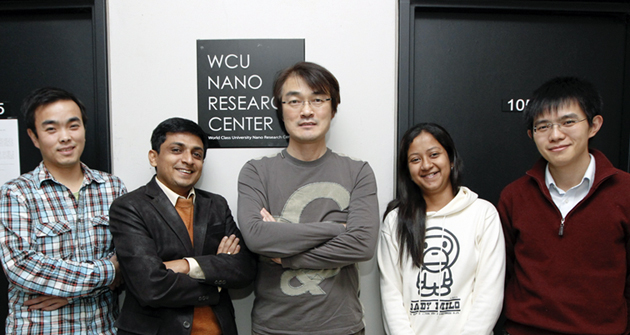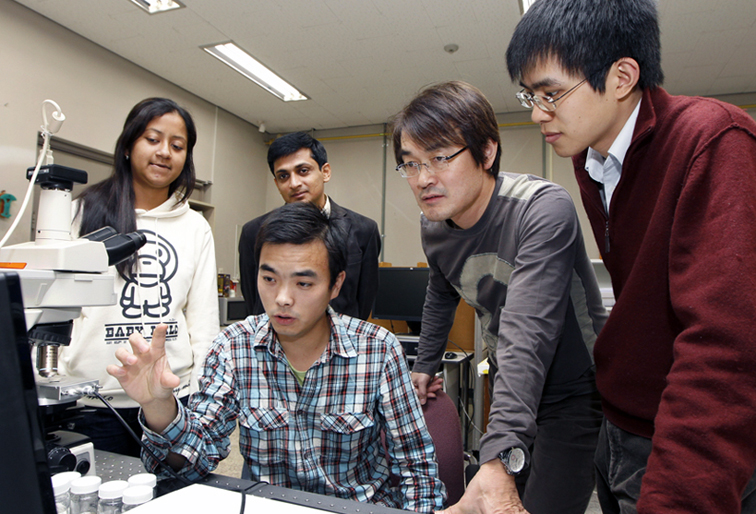“We are World Class!” N
No.88455- Writer YU
- Date : 2012.03.12 10:51
- Views : 12675
WCU nano Research Center publishes a monthly average of 2.3 SCI theses in prominent international journals, half are in Top 10 journals
Ministry of Education, Science and Technology evaluation of ‘A for second straight year’
Nano-patterning technologies using the cell fusion, patent pending in the US, China and Korea
[December 1, 2011]
The word ‘nano’ has now become a commonly used word today. It can be found in various areas of our lives such as in pharmaceutical products, cosmetics, semiconductors, etc, and even in the food industry, there are many products that use nanotechnologies in food processing and wrapping materials. Thus, almost every part of our lives involves some sort of nanotechnologies. Nanotechnology, which etymology comes from the Greek word ‘nanos’, that means ‘midget’, is an advanced technology that deals with ultra-small materials that are 1/100,000 the thickness of human hair or the level of atomic or molecule sizes (1 nanometer=1/1,000,000,000 meters). It is a sector that requires integration of advanced technologies. Recently, research in the bio technology sector such as nano bio analysis, nano bio sensors, nano bio materials, and bio nano machines have become very active.
As seen above, while nanotechnologies have become the ‘top 3 science technologies’ of the 21st century together with information science technologies and Biotechnology, the Yeungnam University WCU nano Research Center (director Joo, Sang-woo, School of Mechanical Engineering, hereinafter called ‘WCUNRC’), which is performing the MEST sponsored ‘WCU (World Class University) project’ has shown forth truly ‘world-class’ research. In the MEST evaluation, it received an A for the second straight year.

Yeungnam University WCUNRC researchers (center: professor Joo, Sang-woo)
The WCUNRC began full-fledged operations from September 2009. It will receive a total of 3.5 billion won until August 2013 from national funding, and it is conducting basic research on nanotechnologies and fusion/convergence technology development projects. The ultimate goal of the WCUNRC is to develop the world’s most advanced technologies in the nano-patterning sector, and commercialize it in various industrial sectors. By doing so, it hopes to bring up Korea’s national competitiveness in the global nano-market, which is expected to rise to 1 trillion dollars by 2015.
In particular, it has recently been concentrating on developing cell fusion technologies using electric stimulation. In result, they developed three types of nano-patterning technologies that can produce high-efficiency Cell Electrofusion Microdevices, and patents have been applied for currently in the US, China and Korea.
The greatest feature of the device that applies this new technology is that it is possible to quickly reap cell fusion results in just ten minutes even with low voltage. Because the electric shock applied on the test cell is very weak and made in a short period of time, cell damage is minimized and the probability for acquiring the desired results were enhanced. In addition, its production cost was also dropped and made in a compact size, which takes up very little room. Thus, its possibility for commercialization rose greatly.
The WCUNRC is currently conducting clinical tests for the device that applies the new technology together with Chongqing University Hospital of China. It is expected that it will contribute greatly not only in cell fusion for medical purposes such as genetic treatment, anti-cancer vaccine development, and immune body research, but also in genetic engineering such as development of new species that contain various animal and plant features. It is also expected to bring about radical progress by being used in various sectors such as niotechnology, immunology, pharmacy, food processing studies, and agricultural studies.
The results of research by the WCUNRC were truly world class. The total number of SCI theses published by the Yeungnam University WCUNRC was 54 during the 24 months from September 2009. Thus, 2.3 theses per month were published in SCI journals under the name of the Yeungnam University WCUNRC. Moreover, there are also 15 theses currently being reviewed for publishing.
During the third project evaluation period (Oct 1, 2010 – Aug 31, 2011), 28 SCI journals were published, and half of them (14) were carried by top journals in the upper 10% such as 《SoftMatter》, 《Physical Chemistry Chemical Physics》, 《Polymer》, 《Electrophoresis》, and 《Nanotechnology》.

Such results were possible thanks to the international efforts and passion for researches by the participating professors. Currently, professors participating in this project are the three starting members of director Professor Joo, Sang-woo (52, School of Mechanical Engineering), Ashutosh Sharma (50), chair professor of the India Institute of Technology (IIT), which is also called the ‘MIT of India’ and one of the world’s top five scholars in nano-patterning, Professor Shizi Qian (40), and Banerjee A. Narayan (36)and Professor Lin Xu (31), who newly joined the team last year.
Since working with the WCU project, they never took a whole day off. Even when they ate, they always inspected each other’s research and made self-assessments comparing the global levels. They stayed up to two to three in the morning to share opinions with each other via e-mail, while Professor Lin Xu, the youngest participating professor, brought a blanket and portable stove to the lab to eat and sleep there while working on the research.
Through such efforts, when including joint research theses, Professor Joo has already published 36 SCI theses, while 12 are being reviewed. Professor Qian published 32 and two are currently being reviewed, Professor Sharma published 21 and seven are being reviewed. These are truly amazing achievements. When considering that it normally takes about six physical months to apply, screen and publish SCI theses, the performance of the WCUNRC is deserving of the title ‘world best’.
Professor Joo stated, “Universities of the US, China, Japan and Europe, which are known as advanced countries in the nanotechnology sector, have difficulty with publishing even 10 SCI theses in a year,” adding, “This was possible by setting apart responsibilities for each member and setting individual research goals, which were then combined in efforts for a common goal.”